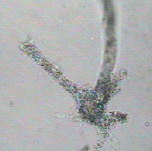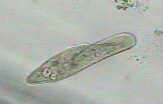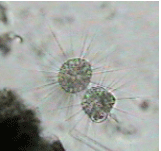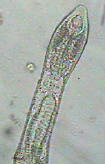|

Closterium sp, a green algae, holoplankton |
The Chlorophyta
are very diverse aquatic plants with over 8000 species ranging from fresh to
marine conditions. However, about 90% are fresh water. They contain
chlorophyll a and b. They store
starch as a food reserve inside
organelles called plastids.
The classification is confusing and not agreed upon by researchers. Most
green algae have firm cell walls. Some contain flagella
while others have calcified shells.
|

Amoeba is a protist with pseudopodia

Paramedium sp., a ciliate protozoa

Heliozoa is a protozoa |
Heterotrophic
representatives would include
protozoa
and small animals like rotifers and gastrotriches. Some
arthropods
can also live their entire life in the water column including water fleas,
ostrocods and copepods. Heterotrophic animals can
ingest
their food (i.e., paramecium) or nutrients can be
adsorbed
through their root or body system (i.e., fungi). There is also the benthic or
bottom living environment. These organisms spend most of their time in the
slimy world of mud. Also Included in this section are organisms that live in
the water column as plankton, but can live in the
benthic
(bottom)
environment.
|

Oligochaeta are fresh water annelids |
Blue-green algae
or cyanobateria are common in the holoplankton . Some are harmful in
that they may add to the pollution of lakes and rivers by their rapid growth,
but most are benign. Cyanobacteria are one of the most primitive organisms
found in the fossil record, making massive mounds 600 million years ago called
stromatolites.
The Protista are single-celled
organisms that have a true nucleus (eukaryotic). Protista may be either
autotrophic or heterotrophic. Movement by protists is dependent upon certain
physical characteristics. Some protozoa have pseudopodia which can
extend the cell membrane and push forward or surround a food particle, such as
an amoeba does. A protist that possesses a single tail-like structure
is called a flagellate. The flagellum will beat back and forth
and propel the organism through the water. Some Protozoa are covered with
tiny hair-like structures called cilia which move back and forth
quickly propelling the organisms through the water. A paramecium is an
example of a ciliate. Some Protozoa have axopodia, or
pencil-like structures, that help them to be planktonic or floaters in the
water. A heliozoan is an example of protozoa with axopodia.
There are many debates about whether
protozoa are all one-celled organisms or whether they are all one-celled
organisms that are heterotrophs. Scientists, who study these groups, debate on
how to classify some of these organisms, like euglena and dinoflagellate. With
more study these groups will be better understood. |